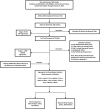There Are No Differences in Short- to Mid-term Survivorship Among Total Hip-bearing Surface Options: A Network Meta-analysis
- PMID: 25516002
- PMCID: PMC4419002
- DOI: 10.1007/s11999-014-4065-0
There Are No Differences in Short- to Mid-term Survivorship Among Total Hip-bearing Surface Options: A Network Meta-analysis
Abstract
Background: Total hip arthroplasty (THA) is increasingly being performed in patients with long life expectancies and active lifestyles. Newer implant bearing surfaces, with superior wear characteristics, often are used in this cohort with the goal of improving longevity of the prosthesis, but comparisons across the numerous available bearing surfaces are limited, so the surgeon and patient may have difficulty deciding which implants to use.
Questions/purposes: The purpose of this study was to answer the following question: Is there a short- to mid-term survivorship difference between common THA bearings used in patients younger than age 65 years?
Methods: We conducted a systematic review to identify randomized clinical trials (RCTs) published after 2000 that reported survivorship of ceramic-on-ceramic (CoC), ceramic-on-highly crosslinked polyethylene (CoPxl), or metal-on-highly crosslinked polyethylene (MoPxl) bearings. To qualify for our review, RCTs had to have a minimum 2-year followup and study patients were required to have an average age younger than 65 years. Direct-comparison meta-analysis and network meta-analysis were performed to combine direct and indirect evidence.
Results: Direct-comparison meta-analysis found no differences among the bearing surfaces in terms of the risk of revision; this approach demonstrated a risk ratio for revision of 0.65 (95% confidence interval [CI], 0.19-2.23; p = 0.50) between CoC and CoPxl and a risk ratio for revision of 0.40 (95% CI, 0.06-2.63; p = 0.34) between CoC and MoPxl. Network meta-analysis (with post hoc modification) likewise found no differences in survivorship across the three implant types, demonstrating the following probabilities of most effective implant with 95% credible intervals (CrI): CoC = 64.6% (0%-100%); CoPxl = 24.9% (0%-100%); and MoPxl = 9.9% (0%-100%). The CrIs ranged from 0% to 100% for all three bearing surfaces. Direct-comparison meta-analysis allowed for pooling of five RCTs, including 779 THAs, whereas network meta-analysis (before post hoc analysis) enabled pooling of 18 RCTs, including 2599 THAs.
Conclusions: Current published evidence does not support survivorship differences among commonly used bearing surfaces in patients younger than age 65 years undergoing THA at short- to mid-term followup. Long-term RCT data will be needed to determine if a survivorship benefit is realized in younger, more active patients over time.
Level of evidence: Level I, therapeutic study.
Figures




Comment in
-
CORR Insights(®): There Are No Differences in Short- to Mid-term Survivorship Among Total Hip-bearing Surface Options: A Network Meta-analysis.Clin Orthop Relat Res. 2015 Jun;473(6):2042-4. doi: 10.1007/s11999-015-4147-7. Epub 2015 Jan 23. Clin Orthop Relat Res. 2015. PMID: 25613407 Free PMC article. No abstract available.
Similar articles
-
No Difference in Revision Rates and High Survival Rates in Large-head Metal-on-metal THA Versus Metal-on-polyethylene THA: Long-term Results of a Randomized Controlled Trial.Clin Orthop Relat Res. 2024 Jul 1;482(7):1173-1182. doi: 10.1097/CORR.0000000000002924. Epub 2023 Dec 12. Clin Orthop Relat Res. 2024. PMID: 38084856 Free PMC article. Clinical Trial.
-
How have alternative bearings and modularity affected revision rates in total hip arthroplasty?Clin Orthop Relat Res. 2014 Dec;472(12):3747-58. doi: 10.1007/s11999-014-3816-2. Clin Orthop Relat Res. 2014. PMID: 25070918 Free PMC article.
-
Do retrieval analysis and blood metal measurements contribute to our understanding of adverse local tissue reactions?Clin Orthop Relat Res. 2014 Dec;472(12):3718-27. doi: 10.1007/s11999-014-3893-2. Clin Orthop Relat Res. 2014. PMID: 25160942 Free PMC article.
-
A Nomogram That Characterizes a Patient's Odds of Developing Squeaking After Fourth-generation Ceramic-on-ceramic THA.Clin Orthop Relat Res. 2023 Jul 1;481(7):1322-1336. doi: 10.1097/CORR.0000000000002573. Epub 2023 Feb 7. Clin Orthop Relat Res. 2023. PMID: 36749832 Free PMC article.
-
What Are the Functional, Radiographic, and Survivorship Outcomes of a Modified Cup-cage Technique for Pelvic Discontinuity?Clin Orthop Relat Res. 2024 Dec 1;482(12):2149-2160. doi: 10.1097/CORR.0000000000003186. Epub 2024 Jul 9. Clin Orthop Relat Res. 2024. PMID: 38991223
Cited by
-
CORR Insights(®): There Are No Differences in Short- to Mid-term Survivorship Among Total Hip-bearing Surface Options: A Network Meta-analysis.Clin Orthop Relat Res. 2015 Jun;473(6):2042-4. doi: 10.1007/s11999-015-4147-7. Epub 2015 Jan 23. Clin Orthop Relat Res. 2015. PMID: 25613407 Free PMC article. No abstract available.
-
[Tribology in hip arthroplasty : Benefits of different materials].Orthopade. 2021 Apr;50(4):259-269. doi: 10.1007/s00132-021-04077-w. Epub 2021 Feb 25. Orthopade. 2021. PMID: 33630110 Review. German.
-
Comparison of Wear Rate between Ceramic-on-Ceramic, Metal on Highly Cross-linked Polyethylene, and Metal-on-Metal Bearings.Rev Bras Ortop (Sao Paulo). 2019 May;54(3):295-302. doi: 10.1055/s-0039-1691762. Epub 2019 Jun 27. Rev Bras Ortop (Sao Paulo). 2019. PMID: 31363284 Free PMC article.
-
Does choice of bearings influence the survival of cementless total hip arthroplasty in patients aged 20-55 years? Comparison of 21,594 patients reported to the Nordic Arthroplasty Register Association dataset 2005-2017.Acta Orthop. 2023 Jun 5;94:266-273. doi: 10.2340/17453674.2023.13384. Acta Orthop. 2023. PMID: 37291896 Free PMC article.
-
Advances in hip arthroplasty surgery: what is justified?EFORT Open Rev. 2017 May 11;2(5):171-178. doi: 10.1302/2058-5241.2.170008. eCollection 2017 May. EFORT Open Rev. 2017. PMID: 28630755 Free PMC article.
References
-
- AOANJR–Australian Orthopaedic Association National Joint Registry. Annual Report 2013. 2013. Available at: https://aoanjrr.dmac.adelaide.edu.au/en/annual-reports-2013. Accessed July 15, 2014.
-
- Bascarevic Z, Vukasinovic Z, Slavkovic N, Dulic B, Trajkovic G, Bascarevic V, Timotijevic S. Alumina-on-alumina ceramic versus metal-on-highly cross-linked polyethylene bearings in total hip arthroplasty: a comparative study. Int Orthop. 2010;34:1129–1135. doi: 10.1007/s00264-009-0899-6. - DOI - PMC - PubMed
Publication types
MeSH terms
Substances
Grants and funding
LinkOut - more resources
Full Text Sources
Medical
Research Materials

